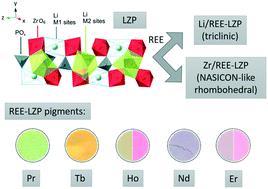当前位置:
X-MOL 学术
›
CrystEngComm
›
论文详情
Our official English website, www.x-mol.net, welcomes your feedback! (Note: you will need to create a separate account there.)
Influence of rare earth elements (REEs) on the structure and optical properties of lithium zirconium phosphate (LZP)
CrystEngComm ( IF 3.1 ) Pub Date : 2020-08-25 , DOI: 10.1039/d0ce00873g Gorodylova Nataliia 1, 2, 3, 4, 5 , Kosinová Veronika 1, 2, 3, 4, 5 , Šulcová Petra 1, 2, 3, 4, 5
CrystEngComm ( IF 3.1 ) Pub Date : 2020-08-25 , DOI: 10.1039/d0ce00873g Gorodylova Nataliia 1, 2, 3, 4, 5 , Kosinová Veronika 1, 2, 3, 4, 5 , Šulcová Petra 1, 2, 3, 4, 5
Affiliation

|
The concept of realisation of different substitution models in REE–LZP crystal structures where REEs occupy either Li+ or Zr4+ crystallographic positions corresponding to triclinic Li1−3xREExZr2(PO4)3 or NASICON-like ion conductive rhombohedral Li1+xZr2−xREEx(PO4)3 phases was verified. Different synthesis approaches (a polymerizable-complex Pechini method and a solid state reaction) were tested to obtain polycrystalline samples with REE = La and x = 0.1. The reaction mechanism in the mixtures was explained using thermal analysis and XRD. On the basis of the obtained results, the most suitable synthesis method with regard to the phase composition (PM) was applied to obtain a whole series of REE–LZPs in order to verify their crystal structure and characterise their optical properties for pigment application. It is shown that realisation of the different substitution models in LZP polycrystalline samples can be distinguished by high resolution X-ray powder analysis that confirmed the co-existence of both types of solid solutions. However, REE–LZP phases have limited thermal stability and under the studied conditions can be obtained only in a mixture with non-substituted β-LZP. Moreover, Li excess, typically used to achieve the formation of pure-phase LZP products, in the studied case induced REE replacement in the LZP structure producing the (REE)PO4 phase. It is shown that some REEs (Nd, Tb, Ho and Pr) induce in LZP ceramics attractive colouration varying from purple to yellow and green shades, which is pre-determined by the crystal structure of the prevailing REE–LZP phase and in some cases is sensitive to ambient light due to the luminescence properties of REEs.
中文翻译:

稀土元素对磷酸锂锆(LZP)结构和光学性能的影响
在REE–LZP晶体结构中实现不同取代模型的概念,其中REE占据与斜晶Li 1–3 x REE x Zr 2(PO 4)3或类似NASICON的离子导电菱面体相对应的Li +或Zr 4+晶体位置验证了Li 1+ x Zr 2− x REE x(PO 4)3相。测试了不同的合成方法(可聚合复合物Pechini方法和固态反应),以得到REE = La和x的多晶样品。= 0.1。用热分析和XRD解释了混合物中的反应机理。根据获得的结果,采用最适合的相组成(PM)合成方法来获得整个REE-LZP系列,以验证其晶体结构并表征其在颜料应用中的光学性能。结果表明,可以通过高分辨率X射线粉末分析来区分LZP多晶样品中不同取代模型的实现,该分析证实了两种类型的固溶体共存。但是,REE-LZP相的热稳定性有限,在研究条件下,只有在与未取代的β-LZP的混合物中才能获得。此外,过量的Li(通常用于实现纯相LZP产物的形成)4阶段。结果表明,某些稀土元素(Nd,Tb,Ho和Pr)在LZP陶瓷中产生诱人的颜色,从紫色到黄色和绿色,这是由主要的REE–LZP相的晶体结构预先确定的,在某些情况下由于REE的发光特性,它对环境光敏感。
更新日期:2020-09-14
中文翻译:

稀土元素对磷酸锂锆(LZP)结构和光学性能的影响
在REE–LZP晶体结构中实现不同取代模型的概念,其中REE占据与斜晶Li 1–3 x REE x Zr 2(PO 4)3或类似NASICON的离子导电菱面体相对应的Li +或Zr 4+晶体位置验证了Li 1+ x Zr 2− x REE x(PO 4)3相。测试了不同的合成方法(可聚合复合物Pechini方法和固态反应),以得到REE = La和x的多晶样品。= 0.1。用热分析和XRD解释了混合物中的反应机理。根据获得的结果,采用最适合的相组成(PM)合成方法来获得整个REE-LZP系列,以验证其晶体结构并表征其在颜料应用中的光学性能。结果表明,可以通过高分辨率X射线粉末分析来区分LZP多晶样品中不同取代模型的实现,该分析证实了两种类型的固溶体共存。但是,REE-LZP相的热稳定性有限,在研究条件下,只有在与未取代的β-LZP的混合物中才能获得。此外,过量的Li(通常用于实现纯相LZP产物的形成)4阶段。结果表明,某些稀土元素(Nd,Tb,Ho和Pr)在LZP陶瓷中产生诱人的颜色,从紫色到黄色和绿色,这是由主要的REE–LZP相的晶体结构预先确定的,在某些情况下由于REE的发光特性,它对环境光敏感。



























 京公网安备 11010802027423号
京公网安备 11010802027423号